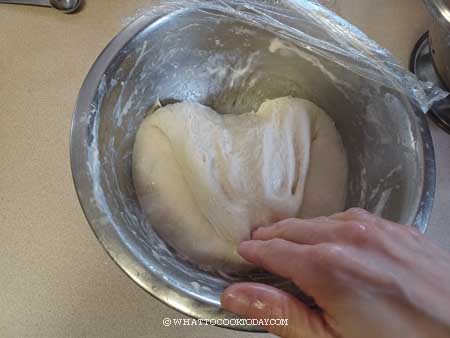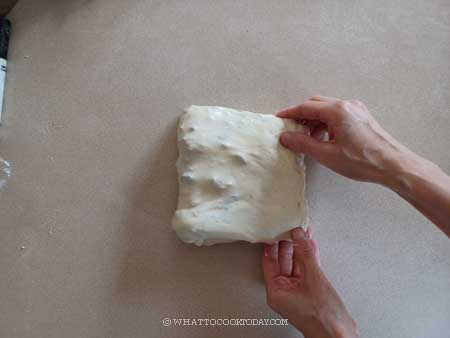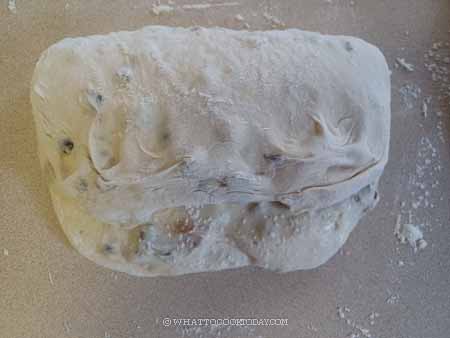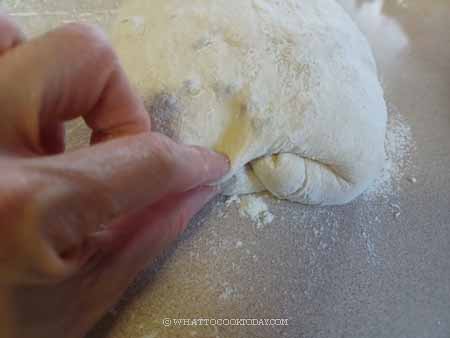This post may contain affiliate links. Please read our disclosure policy.
Delicious no-knead sourdough bread studded with chopped olives and bacon. It is crusty on the outside and with soft custardy open crumbs.

I love me a basic no-knead sourdough country bread any time of the day! But when I decided to add some bits of black olives and bacon bits, this upgraded version is very much welcomed as well. The kids love them even more.
Why you’ll love this recipe
1. It’s a no-knead bread
2. I include about 20% of whole wheat and it contributes to that hint of nuttiness
3. The crumbs are reasonably open and creamy
4. If you are unclear about the process, please feel free to watch the video of how I make sourdough bread in general.

Ingredients and substitutions
1. Bread flour
I usually use King Arthur’s bread flour, which has about 12.7% protein content. I won’t recommend anything lower than this
2. Whole wheat flour
I use regular whole wheat flour. You can also use other whole grains such as spelt and medium-dark or dark rye but make sure you reserve about 10-20 grams of water first and see how the dough behaves before adding all.
3. Water
I usually use filtered water for my sourdough bake
4. Active starter (100% hydration)
You can read here how to make and maintain a small-batch sourdough starter
5. Salt
I usually use fine sea salt. You can adjust the amount according to your taste preference
6. Inclusions: bacon bits, black olives, shredded cheese
I use store-bought good-quality bacon bits. Make sure you drain off the liquid from the black olives and pat them dry with an absorbent paper towel and chop them finely. I also use shredded cheddar cheese. You can substitute with different kinds of olives and cheese
Sample of timeline for this bake
Making a no-knead sourdough bread takes time. Not much active time, but it takes time for the dough to develop its strength and go through fermentation. This schedule is more appropriate for a weekend if you don’t have to go out.
The night before – prepare a starter that will peak right at the time you are going to use it for baking. The temperature was maintained at 75-77 F (24-25 C)
8:00 am– fermentolyse (mix everything and rest for 1 hour) bulk fermentation starts here
9:00 am– stretch and fold #1
9:15 am– stretch and fold #2
9:30 am– stretch and fold #3
10:00 am– Lamination – to strengthen the dough and to add inclusions
10:45 am – coil fold #1
11:30 am – coil fold #2 if needed
12:15 pm – coil fold #3 if needed
2:30 pm – check and see how much the dough has grown. If it has grown to about 50% in volume, it’s time to shape
3:00 pm – transfer dough to a cold fridge for cold retard 18-20 hours
The next day – score and bake the cold dough

How to make no-knead sourdough olives and bacon country bread
1. Weigh 60 grams of starter into a mixing bowl. Feed the starter as per your normal routine. Combine starter, water, and salt and stir to combine. Add the bread flour and whole wheat flour to a mixing bowl. If you have a dough whisk, you can use that, otherwise, a sturdy spatula or your hand would work too. 
2. Stir to combine into a rough wet dough. The whole process probably takes about 3-5 minutes. It is important that there shouldn’t be any visible dry bits. All flour needs to be fully hydrated. Cover and let it sit for 1 hour. Maintain dough temperature at 70-72 F (21-22 C) at this stage if possible
3. Stretch and Fold #1: From this point on, I maintain the temperature a bit warmer, at 75-78 F (24-26C).Please watch the video to see the step-by-step tutorial there. Wet your fingers lightly. Pick up the dough from one of the edge, kinda wiggle it and stretch it up and fold it over. Repeat this throughout the edge of the dough. You may end up with 5-6 stretches



4. Only stretch as far as the dough allows you too, don’t force it. Cover and rest for 15 minutes. Repeat again for Stretch and fold # 2 and #3 if needed, with 30-minute rest in between
5. Lamination: This is a good way to add inclusions to your dough. In this case, the chopped olives and bacon bits. It also helps to strengthen the dough. Lightly wet your fingers and the work surface with a bit of water. Don’t make the work surface too wet because the dough will slide around and you won’t be able to stretch the dough. Transfer the dough onto the work surface. Start stretching from the center to the edge until you get roughly a rectangle. You don’t need to stretch until very thin



6. Spread out the mixture of bacon and olives on top of the stretched-out dough
7. Then gently fold 1/3 to the center from the longer side and then another 1/3 to the center. Then fold the dough on its length, about 3 folds. Pop out any air bubbles if you see any.



8. Transfer the dough to a 9 x 9 or larger container or baking dish or pan and lightly spray the container with non-stick spray. This helps you to see when the dough has spread and how much it has grown in volume. Cover the dough and let it rest for 30 minutes
9. If after 30 minutes the dough still seems pretty strong and hasn’t spread much, wait another 15 minutes to let it relax and spread more then do a coil fold. You can see here that the dough has spread out a bit. 
10. Lightly wet your fingers again and tuck your fingers underneath the dough on the side. Lift the dough up gently. Allow the dough to coil and fold over itself. Rotate the container 90 degrees and do the same on the opposite side. After that rotate 45 degrees and do another coil fold and then rotate the container to coil fold the opposite side. So a total of 4 coil folds (one on each side). These two photos were from different loaf I baked. I just want to show you how the coil fold is done. You can watch a short video on the post above on how to do coil fold. Cover and let it rest for 45 minutes

11. If the dough has spread again, do a coil fold # 2 and # 3 on all 4 sides or if the dough is not very slack, you can coil fold just 2 sides. If the dough hasn’t spread much, wait another 15 minutes and then do the coil fold. Cover and rest for 45 minutes in between. This is after the last coil fold.
12. After about 1 1/2 to 2 hours since the last coil fold, check and see how much the dough has grown. You can visually observe how much the dough has grown in size. It should look about 50% puffier than before. Total bulking time from the time the starter is added to this end of bulk fermentation is about 5 1/2-6 hours at 75-78 F (24-26 C). Again, you need to observe the dough, not the clock. It may take longer or faster depending on the temperature
13. I don’t do pre-shaping since I only bake one small loaf and the dough usually seems pretty strong after all those stretch and folds and coil folds. I also try not to handle the dough too much near the end of bulk fermentation, to avoid degasing the dough too much
14. Lightly flour the surface of the dough in the container. Tip the container upside down to let the dough gently slide down upside down. Dust the surrounding of the dough with flour. Since I use a square container, the dough will be sort of “squarish”. If you use a round container, the dough will be “roundish”
15. Just use a bench knife to help you stretch the dough out a bit to make it more “squarish”. It doesn’t have to be a picture-perfect square. Use a bench knife to tuck in the flour underneath the four edges of the dough
16. Gently fold half of the dough over towards you to the center. Repeat with the opposite half, overlapping the first half. 

17. Then roll the dough over from one end to the other. You can feel that the dough is jiggly and full of air. Tuck a bench knife under one side of the dough and push gently to tighten the dough a bit. 

18. Seal both ends
19. I use an 8-inch oval banneton lined with a cloth. 9-inch banneton would work too. Lightly dust the cloth with rice flour on the bottom and the side of the cloth. Lightly dust the top of the shaped dough. Dust off some excess. Very gently, using the help of the bench scraper to flip the dough onto your palm. So the seam side is facing you now. Gently put the dough into the prepared banneton. The seam side is up. 
20. I like to tighten and seal the seam by pulling a bit of the dough from both sides
21. Place the dough inside a produce plastic bag and twist the bag and secure it with a clip. Any large ziploc bag would work too. Put this inside the coldest part of your fridge. Make sure the fridge is cold enough at 37-38 F (3-4 C). This is important so the dough won’t continue to ferment and you end up with an over-proofed dough. Let the dough cold retard for 18-20 hours. Then score and bake straight from the fridge (follow the recipe instructions below)

Did you make this sourdough olives and bacon country bread recipe?
I love it when you guys snap a photo and tag it to show me what you’ve made. Simply tag me @WhatToCookToday #WhatToCookToday on Instagram and I’ll be sure to stop by and take a peek for real!

No-Knead Sourdough Olives and Bacon Country Bread (Pain De Campagne)
Ingredients
- 230 g bread flour (12.7% protein content) 77%
- 70 g whole wheat flour 23%
- 240 g water 82% final hydration
- 60 g active starter (100% hydration) 20%
- 5 g salt 2%
Inclusions:
- 40 g black olives drained, finely chopped
- 30 g bacon bits finely chopped
Instructions
Prepare levain (the night before):
- I strongly encourage you to have an active starter that is at least one month old before you attempt to bake this recipe. You can try using your young starter that is at least 2-week old, but the result may not be as satisfactory
- Since I know I will be baking the next day, I will prepare more starter the night before. I will feed at 1:7:7 ratio so it will last me until the next morning, about 10 hours to double or triple at 75-77 F (24-25C). This also depends on the strength of your starter and the room temperature the starter is at. It may be faster or longer.
- I use 5 grams starter + 35 grams flour + 35 grams water. I usually prepare a bit more as some may get stuck to the glass jar, spatula, etc.
- Remember that you want to use your starter at its peak, meaning it has doubled or tripled when you are ready to use it
Fermentolyse: (8:00 am)
- Weigh 60 grams of starter into a mixing bowl. Feed the starter as per your normal routine. Combine starter, water, and salt and stir to combine. Add bread flour and whole wheat flour to a mixing bowl. If you have a dough whisk, you can use that, otherwise, a sturdy spatula or your hand would work too. Stir to combine into a rough wet dough. The whole process probably take about 3-5 minutes. It is important that there shouldn't be any visible dry bits. All flour needs to be fully hydrated. Cover and let it sit for 1 hour. Maintain dough temperature at 70-72 F (21-22 C) at this stage if possible
- If it's really warm where you are, you may want to put it in a cooler bag with a pack of ice. Because the starter is already added at this point, we don't want it to start fermenting way too early before we have a chance to strengthen the dough during bulk fermentation
- Bulk fermentation begins when you innoculate starter (adding starter) into the dough. In this case, it starts at this fermentolyse step
Stretch and Fold # 1:
- From this point on, I maintain the temperature a bit warmer, at 75-78 F (24-26C).Please watch the video to see the step-by-step tutorial there. Wet your fingers lightly. Pick up the dough from one of the edge, kinda wiggle it and stretch it up and fold it over. Repeat this throughout the edge of the dough. You may end up with 5-6 stretches
- Only stretch as far as the dough allows you too, don't force it. Cover and rest for 15 minutes
Stretch and fold #2 (around 9:15 am):
- Do the same stretch and fold again with your slightly wet fingers. You may notice the dough is a bit tighter this round as gluten has developed a bit more. Cover and rest for 15 minutes
Stretch and fold #2 (around 9:30 am):
- Repeat the same step again and then rest for 30 minutes
Lamination: (around 10:00 am):
- Lamination is a good way to add inclusions into your dough. In this case, the chopped olives and bacon bits. It also helps to strengthen the dough
- Lightly wet your gingers and the work surface with a bit of water. Don't make the work surface too wet because the dough will slide around and you won't be able to stretch the dough
- Transfer the dough onto the work surface. Start stretching from the center to the edge until you get roughly a rectangle. You don't need to stretch until very thin
- Spread out the mixture of bacon, cheese, and olives on top of the stretched-out dough. Then gently fold 1/3 to the center from the longer side and then another 1/3 to the center. Then fold the dough on its length, about 3 folds. Pop out any air bubbles if you see any
Transfer to a bulking dish: (around 10:15 am)
- Transfer the dough to a 9 x 9 or larger container or baking dish or pan and lightly spray the container with non-stick spray. This helps you to see when the dough has spread and how much it has grown in volume
- Cover the dough and let it rest for 30 minutes
Coil fold #1: (around 10: 45 am)
- If after 30 minutes the dough still seems pretty strong and hasn't spread much, wait another 15 minutes to let it relax and spread more then do a coil fold. Lightly wet your fingers again and tuck your fingers underneath the dough on the side
- Lift the dough up gently. Allow the dough to coil and fold over itself
- Rotate the container 90 degrees and do the same on the opposite side. After that rotate 45 degrees and do another coil fold and then rotate the container to coil fold the opposite side. So a total of 4 coil folds (one on each side). You can watch a short video on the post above on how to do coil fold
- Cover and let it rest for 45 minutes
Coil fold #2: (around 11:30 am)
- If the dough has spread again, do a coil fold on all 4 sides or if the dough is not very slack, you can coil fold just 2 sides. If the dough hasn't spread much, wait another 15 minutes and then do the coil fold. Cover and rest for 45 minutes
Coil fold #3: (around 12:15 pm)
- You may or may not need the 3rd coil fold. This depends on how extensible the dough is at this point. If the dough still seems slack and does not have much strength, then definitely do coil fold #3. If the dough seems strong and doesn't spread much, you may skip coil fold, or you can just do 2 coil folds instead of 4. Cover and let it continue to bulk ferment
- Remember that you need to observe your dough (read the dough not the clock) and do necessary action only if it is needed. This is one of the keys to successful sourdough baking
Let the dough continue to bulk ferment:
- After about 1 1/2 to 2 hours since the last coil fold, check and see how much the dough has grown. You can visually observe how much the dough has grown in size. It should look about 50% puffier than before.
- Total bulking time from the time the starter is added to this end of bulk fermentation is about 5 1/2-6 hours at 75-78 F (24-26 C). Again, you need to observe the dough, not the clock. It may take longer or faster depending on the temperature
Shaping: (around 3 pm):
- I don't do pre-shaping since I only bake one small loaf and the dough usually seems pretty strong after all those stretch and folds and coil folds. I also try not to handle the dough too much near the end of bulk fermentation, to avoid degasing the dough too much
- Lightly flour the surface of the dough in the container. Tip the container upside down to let the dough gently slide down upside down. Dust the surrounding of the dough with flour. Since I use a square container, the dough will be sort of "squarish". If you use a round container, the dough will be "roundish"
- Just use a bench knife to help you stretch the dough out a bit to make it more "squarish". It doesn't have to be a picture-perfect square. Use a bench knife to tuck in the flour underneath the four edges of the dough
- Gently fold half of the dough over towards you to the center. Repeat with the opposite half, overlapping the first half. Then roll the dough over from one end to the other. You can feel that the dough is jiggly and full of airTuck a bench knife under one side of the dough and push gently to tighten the dough a bit. Seal both ends
Transfer to an oval banneton: (batard shape)
- I use an 8-inch oval banneton lined with a cloth. 9-inch banneton would work too. Lightly dust the cloth with rice flour on the bottom and the side of the cloth. Lightly dust the top of the shaped dough. Dust off some excess. Very gently, using the help of the bench scraper to flip the dough onto your palm. So the seam side is facing you now. Gently put the dough into the prepared banneton. The seam side is up. I like to tighten and seal the seam by pulling a bit of the dough from both sides
Cold retard in the fridge:
- Place the dough inside a produce plastic bag and twist the bag and secure with a clip. Any large ziploc bag would work too. Put this inside the coldest part of your fridge. Make sure the fridge is cold enough at 37-38 F (3-4 C). This is important so the dough won't continue to ferment and you end up with an over-proofed dough. Let the dough cold retard for 18-20 hours
Preheating oven: (The next day when you are ready to bake it)
- I bake using a cast-iron dutch oven. 30 minutes before you plan to bake, position one oven rack at the lowest level and then another one rack above it. Place the dutch oven and its lid on the 2nd rack. I keep the pot and the lid separated during preheating. Preheat the oven together with the dutch oven to 500 F (260 C) for 30 minutes
- Cut a parchment paper about 2 inches bigger than the size of your banneton. I have a combo cooker Dutch oven, which is nice because I can load the dough with less risk of getting burnt on my arms. If you have a regular Dutch oven pot, you want to cut parchment paper so that it has a "handle" so you can lift the handle and lower the dough into the pot without getting burnt.
Scoring the dough:
- When the oven has preheated for 30 minutes, get the dough out from the refrigerator. There is no need to let it come to room temperature. Use a bread lame and make a slash, about 1/2-inch deep at 45-degree angles on the dough, kinda off-center a bit. Mist the dough with water. This creates nice crackling all around the crust later
- Place the parchment paper covering the top of the banneton and turn it over so the dough is now sitting on top of the parchment paper
- Use a bread lame and make a slash, about 1/2-inch deep at 45 degree angles on the dough, kinda off-center a bit. It can be a bit challenging to score because of the pumpkin seeds, but just do your best. Mist the dough with water. This creates nice crackling all around the crust later
Baking:
- Wear a mitten and carefully get the Dutch oven pot and its lid out from the oven and place one baking sheet on the lowest rack and quickly but carefully close the oven's door back to prevent too much heat loss. This helps to prevent the bottom crust of your bread from being too thick and tough
- Carefully load the dough by lifting the parchment paper and lower it into the pot or the combo cooker. Close the lid. Open the oven door again and carefully transfer the pot into the oven again and close the oven door. Lower the temperature to 450 F (230 C) and bake for 30 minutes
- After 30 minutes remove the Dutch oven from the oven. Transfer the half-baked bread to a regular baking sheet and put this back inside the oven. Again, this is to help create a nice thin crust all around
- Lower the oven temperature to 425 F (220 C) and bake for 15 minutes. Rotate the bread halfway during this second portion of baking
- After 15 minutes, turn off the oven and open the oven door slightly to let the hot air out and let the bread sit in the oven for 15 minutes. This helps to "cure" the bread without overcooking it, so the inside won't be wet and gummy
Cooling down:
- After that, get the bread out of the oven and transfer it to a cooling rack immediately and now comes the hardest part! You need to wait for at least 3-4 hours or longer before you slice it. If you slice into warm bread, you will end up with gummy crumbs
Store:
- Once the bread has cooled down completely, you can store it in a bread box if you plan to consume it in the next few days. You can also put it inside a paper bag
- For longer storage, you can wrap the whole loaf or sliced bread in plastic wrap and then put inside a freezer bag. Push all the air out and seal. It can be kept frozen for 1-2 months. Simply thaw at room temperature before serving and then reheat them in toaster or air-fryer. Most toasters these days can toast frozen sliced bread. So you may not even need to thaw it completely




